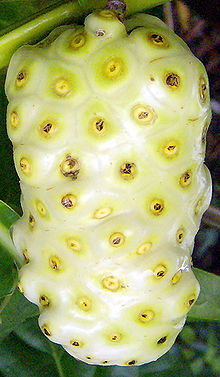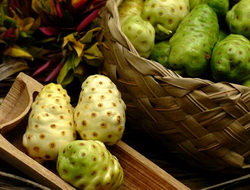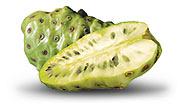.jpg/170px-Noni_fruit_(Morinda_citrifolia).jpg) Morinda citrifolia, commonly known as great morinda, Indian mulberry, nunaakai (Tamil Nadu, India), dog dumpling (Barbados), mengkudu (Malaysia), beach mulberry, cheese fruit or noni (from Hawaiian) is a tree in the coffee family, Rubiaceae. Morinda citrifolia is native from Southeast Asia to Australia and is now distributed throughout the trop.
Morinda citrifolia, commonly known as great morinda, Indian mulberry, nunaakai (Tamil Nadu, India), dog dumpling (Barbados), mengkudu (Malaysia), beach mulberry, cheese fruit or noni (from Hawaiian) is a tree in the coffee family, Rubiaceae. Morinda citrifolia is native from Southeast Asia to Australia and is now distributed throughout the trop.Noni grows in shady forests as well as on open rocky or sandy shores. It reaches maturity in about 18 months and then yields between 4–8 kilograms (8.8–18 lb) of fruit every month throughout the year. It is tolerant of saline soils, drought conditions, and secondary soils. It is therefore found in a wide variety of habitats: volcanic terrains, lava-strewn coasts, and clearings or limestone outcrops. It can grow up to 9 metres (30 ft) tall, and has large, simple, dark green, shiny and deeply veined leaves.
 The Noni plant is known among the people of the tropics world-wide. In Malaysia, it is known as Mengkudu. In Southeast Asia it is known as Nhau. In the islands of the South Pacific the plant is known as Nonu, in Samoa and Tonga. Nono in Raratonga and Tahiti, and Noni in the Marquesas Islands and Hawaii becoming and integral part of the Polynesian culture. An important source of food, the fruit of the Noni tree has been used for centuries as a food source. Early Polynesians recognized its pure value and consumed it in times of famine.
The Noni plant is known among the people of the tropics world-wide. In Malaysia, it is known as Mengkudu. In Southeast Asia it is known as Nhau. In the islands of the South Pacific the plant is known as Nonu, in Samoa and Tonga. Nono in Raratonga and Tahiti, and Noni in the Marquesas Islands and Hawaii becoming and integral part of the Polynesian culture. An important source of food, the fruit of the Noni tree has been used for centuries as a food source. Early Polynesians recognized its pure value and consumed it in times of famine. Despite its strong smell and bitter taste, the noni fruit became a staple food choice for people of Raratonga, Samoa and Fiji who ate the noni fruit raw or cooked. Australian Aborigines consume the fruit raw with salt or cook it with curry. The seeds are edible when roasted. Seeds, leaves, bark and root were also consumed by people familiar with the qualities of this unusual plant. Traditionally, every part of the Morinda Citrifolia plant is valued and used.
 The plant bears flowers and fruits all year round. The fruit is a multiple fruit that has a pungent odor when ripening, and is hence also known as cheese fruit or even vomit fruit. It is oval in shape and reaches 4–7 centimeters (1.6–2.8 in) size. At first green, the fruit turns yellow then almost white as it ripens. It contains many seeds. It is sometimes called starvation fruit. The noni is especially attractive to weaver ants, which make nests out of the leaves of the tree. These ants protect the plant from some plant-parasitic insects. The smell of the fruit also attracts fruit bats, which aid in dispersing the seeds.
The plant bears flowers and fruits all year round. The fruit is a multiple fruit that has a pungent odor when ripening, and is hence also known as cheese fruit or even vomit fruit. It is oval in shape and reaches 4–7 centimeters (1.6–2.8 in) size. At first green, the fruit turns yellow then almost white as it ripens. It contains many seeds. It is sometimes called starvation fruit. The noni is especially attractive to weaver ants, which make nests out of the leaves of the tree. These ants protect the plant from some plant-parasitic insects. The smell of the fruit also attracts fruit bats, which aid in dispersing the seeds.Nutrients and phytochemicals
Noni fruit powder is high in carbohydrates and dietary fiber. According to the College of Tropical Agriculture and Human Resources at the University of Hawaii at Mānoa, a 100 g sample of the powder contains 71% Carbohydrate and 36% Fiber. The sample also contained 5.2% Protein and 1.2% Fat. These macronutrients evidently reside in the fruit pulp, as noni juice has sparse amounts of macronutrients.
The main micronutrients of noni pulp powder include 9.8 mg of Vitamin C per 1200 mg sample, as well as 0.048 mg Niacin (vitamin B3), 0.02 mg Iron and 32.0 mg Potassium. Vitamin A, Calcium and Sodium are present in moderate amounts. When noni juice alone is analyzed and compared to pulp powder, only Vitamin C is retained at a high level, 33.6 mg per 100 g of juice.
Although the most significant nutrient feature of noni pulp powder or juice is its high vitamin C content, noni fruit juice provides only about half the vitamin C of a raw navel orange. Sodium levels in noni juice (about 3% of DRI) are high compared to an orange. Although the potassium content appears relatively high for noni, this total is only about 3% of the Recommended Dietary Allowance and so would not be considered excessive. Noni juice is otherwise similar in micronutrient content to a raw orange.
 Noni fruit contains a number of phytochemicals, including lignans, oligo- and polysaccharides, flavonoids, iridoids, fatty acids, scopoletin, catechin, beta-sitosterol, damnacanthal, and alkaloids. Although these substances have been studied for bioactivity, current research does not conclude anything about their effects on human health. These phytochemicals are not unique to noni, as they exist in various plants.
Noni fruit contains a number of phytochemicals, including lignans, oligo- and polysaccharides, flavonoids, iridoids, fatty acids, scopoletin, catechin, beta-sitosterol, damnacanthal, and alkaloids. Although these substances have been studied for bioactivity, current research does not conclude anything about their effects on human health. These phytochemicals are not unique to noni, as they exist in various plants.Possible medicinal properties
Noni has been evaluated unsuccessfully in preliminary clinical trials for possible use in treating cancer, although the US National Cancer Institute has undertaken further preliminary studies for potential preventive effects against breast cancer. Since 2007, there have been no other registered clinical trials on potential health benefits or anti-disease effects of noni which remains scientifically undefined for any effect on human health.
Traditional medicine
 Applications in folk medicine have not been verified by modern science or confirmed scientifically to enhance health or prevent disease. Although unsupported by science, the green fruit, leaves and the root/rhizome were traditionally used to treat menstrual cramps, bowel irregularities and urinary tract infections. Traditional Medicinal Uses are as below :
Applications in folk medicine have not been verified by modern science or confirmed scientifically to enhance health or prevent disease. Although unsupported by science, the green fruit, leaves and the root/rhizome were traditionally used to treat menstrual cramps, bowel irregularities and urinary tract infections. Traditional Medicinal Uses are as below :*Parts of the fruit are used as a tonic and to contain fever (China, Japan, Hawaii)
*The leaves, flowers, fruit, and bark can treat eye problems, skin wounds and abscesses, gum and throat problems, respiratory ailments, constipation, and fever (Pacific Islands, Hawaii)
*Used to treat stomach pains and after delivery (Marshall Islands)
*Heated leaves applied to the chest relieve coughs, nausea, and colic (Malaysia)
*Juice of the leaves is taken for arthritis (Philippines)
*Pounded, unripe fruit is mixed with salt and applied to cuts and broken bones
*Ripe fruit is used to draw out pus from an infected boil (Hawaii)
*Juices of over-ripe fruits are taken to regulate menstrual flow and ease urinary problems (Malaysia)
*The fruit can be used to make shampoo (Malaysia, Hawaii) and to treat head lice (Hawaii).
*Other exotic diseases treated with the plant include diabetes (widespread) and venereal diseases.
Consumer applications
 The bark of the great morinda produces a brownish-purplish dye for batik making. In Hawaii, yellowish dye is extracted from its roots to dye cloth.
The bark of the great morinda produces a brownish-purplish dye for batik making. In Hawaii, yellowish dye is extracted from its roots to dye cloth.There have been recent applications for the use of noni seed oil which contains linoleic acid possibly useful when applied topically to skin, e.g., anti-inflammation, acne reduction, moisture retention.
Source, Images: http://en.wikipedia.org/wiki/Noni








1 comments:
Nice article. Good to see this
Great suggestions ! I love this blog, but can’t lay there all day everyday.
Thank You Very Much for posting this.
Vegan Recipes
Post a Comment